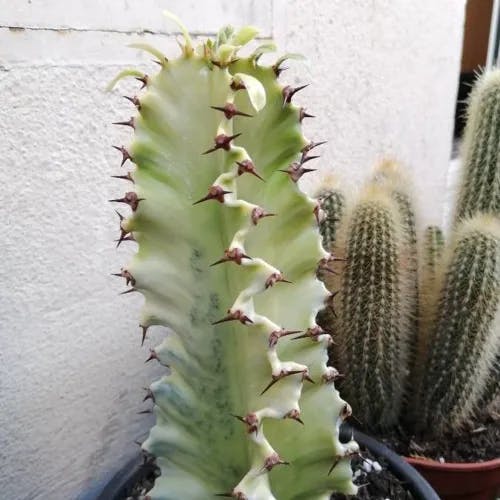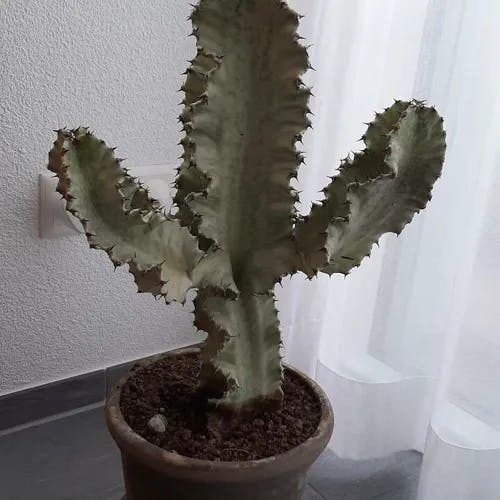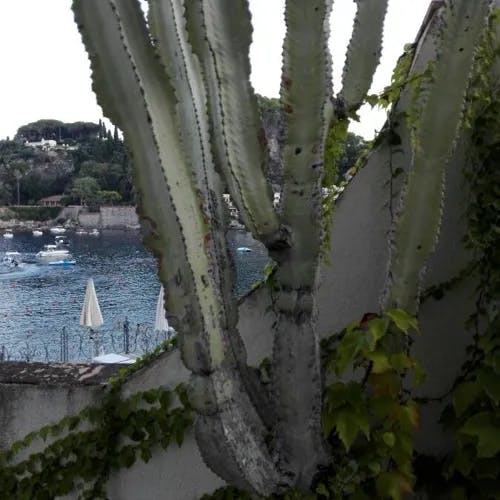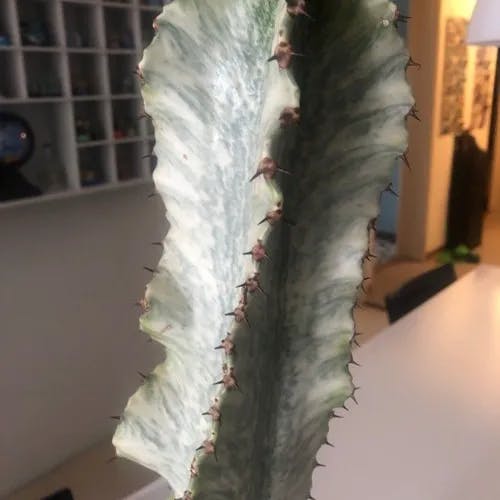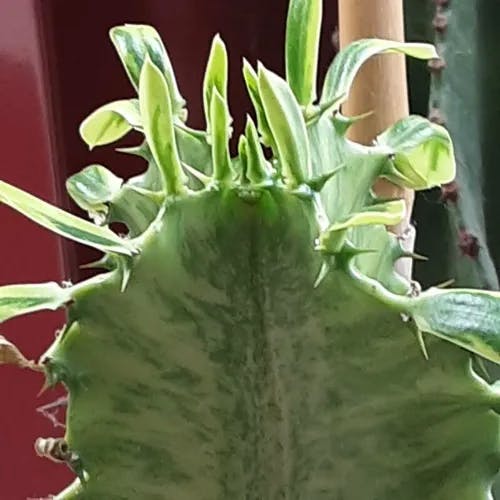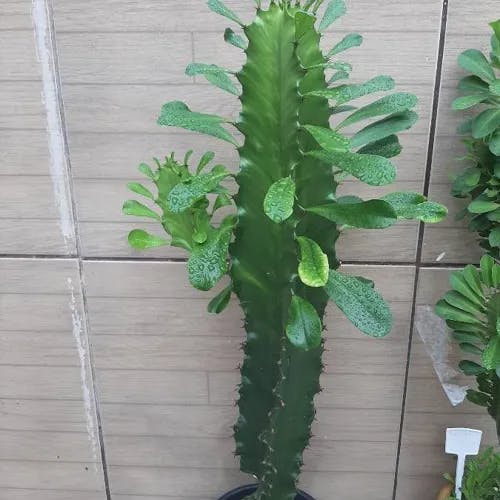The unusually shaped African candelabra plant is scientifically termed Euphorbia ammak. This spiny succulent thrives in the hot, arid Somalia and Ethiopia. Reaching 6 meters tall, its thick green stems and branches seem tree-like. Tiny yellowish blooms sprout in clusters at branch tips. Although this plant bears no fruit, its three-lobed seed capsules follow the flowers. Easy propagation occurs in well-drained, sunny sites. Take care when handling the sharp spines that defend its fleshy water-storing stems and leaves. Valued as ornamentals, these exotic-looking plants bring architectural flair to gardens and landscapes.
African candelabra
- Scientific name
- Euphorbia ammak
Basic Information
- Euphorbiaceae Family Euphorbia Genus African candelabra Species
- Euphorbiaceae > Euphorbia > Euphorbia ammak
- 83%
- The Completeness of This Encyclopedia
Please help us complete the encyclopedia, Terrarium is a encyclopedia service to be completed with everyone in the world. Currently, this page is 83% complete. For more information on how to contribute, please click here.
- Shrub
- Height
- 600cm ~
- Flower Color
- Leaf Color
- Anthesis
- Sunlight Exposure
Full Sun Long hours of sunlight from morning to afternoon Partial Shade A location in the shade of a tree or where either the morning or afternoon is shaded Full Shade A place where there is no direct sunlight
- Full Sun
- Hardiness Zones
This is an indicator to know to which zone each plant can winter. Knowing the zone of each plant gives you an idea of the cold temperature resistance when grown in the ground without a roof. 2: -42.7 to -40.0 3: -39.9 to -34.4 4: -34.3 to -28.9 5: -28.8 to -23.3 6: -23.2 to -17.8 7: -17.7 to -12.2 8: -12.1 to -6.7 9: -6.6 to -1.1 10: -1.0 to 4.4 11: 4.5 to 10.0
- 10
- Cold resistance
- Poor
- Heat resistance
- Excellent
- Habitat of origin
- Yemen
- Growth Rate
- Normal
What is African candelabra (Euphorbia ammak)?
What is African candelabra (Euphorbia ammak)
Flower meaning
The African candelabra called Euphorbia ammak scientifically fails to possess any flower tongue shared in the USA. America's flower vernacular changes according to time period, civilization, and nation. No precise reference exists to the African candelabra in America's flower language. Note however that the African candelabra constitutes a succulent endemic to Africa's arid areas, known for its singular candelabra shape. Generally, succulents link with resilience, strength, and flexibility. Succulents earn admiration for prospering in harsh conditions, symbolizing endurance and perseverance. Although no precise flower tongue belongs to the African candelabra, its distinctive traits and survival in difficult environments allow varied interpretation and appreciation.
Calendar of African candelabra (Euphorbia ammak)
Calendar
African euphorbias, scientifically Euphorbia ammak, dwell as succulents endemic in arid African regions. Within the United States, this cactus usually blossoms during spring and summer months. Flowering times of African euphorbias vary according to specific nurturing conditions and weather. However, generally blossoms excel during May through August. Blossoming lasts several weeks, with individual flowers diurnally opening and closing. For extended blooming, provide ample sunlight, well-draining earth, and regular watering. Furthermore, prevent overwatering and shield from temperature extremes prolonging the flowering season.
How to grow African candelabra (Euphorbia ammak)
Watering
The optimal recurrence and technique of moistening for the African candlestick factory relies on miscellaneous constituent parts. While the growing flavor, which characteristically materializes in bounce and summer, the factory beseeches habitual watering to uphold dirt wetness. It is counselled to moisten the factory formerly every 7-10 days, ensuring that the dirt is evenly soggy although not waterlogged. The quantity of fluid indispensable can alter contingent on the dimension of the factory and the flowerpot it is in, nevertheless, watering pending the fluid inaugurates to empty from the base of the flowerpot is adequate. Contrastingly, during the dormant flavor in decline and winter, the factory beseeches fewer frequent watering. It is advisable to decrease watering to formerly every 2-3 weeks, sanctioning the dirt to dry outward slightly between waterings. Scrutinizing the dirt humidity and adjusting the watering recurrence accordingly is crucial for the health of the African candlestick factory.
Soil and Fertilizer
Euphorbia ammak, scientifically monikered the African candelabra, prospers in adequately aerated ground containing a pH spectrum of 6.0 toward 7.5. It favors arenaceous or loamy terrain enriched with organic material. The dirt ought retain several fluid but not become waterlogged. To assure optimal maturation, it is counseled to feed the African candelabra during the cultivation season, typically vernal and estival. A counterpoised fertilizer with coequal quantities of nitrogen, phosphorus, and metal (NPK) suffices. The fertilizer should be employed every 4 toward 6 weeks, shadowing the manufacturer's book of instructions for the decorous quantity. Earlier applying fertilizer, it is crucial to irrigate the flora thoroughly to forbid root combustion. The fertilizer could be spread evenly encircling the pedestal of the flora, avoiding direct conjunction with the stems or leaves. Subsequently application, the soil should be irrigated again to assist the nutrients penetrate the root zone. Habitual soil testing is counseled to monitor the pH and nutrient levels in the soil. Adjustments could be created accordingly to maintain the optimal soil stipulations for the African candelabra.
Sunlight and Place
The plant native to Africa referred to as the African candelabra is scientifically termed Euphorbia ammak. It endures both frigid and torrid environments, allowing it to prosper in diverse climates. However, temperatures nearing freezing or exceeding 100 degrees Fahrenheit may impair its vigor. Regarding ideal temperatures, the African candelabra thrives between 60 and 85 degrees Fahrenheit. In summer, situating the plant where it absorbs direct sun for a minimum of 6 hours daily optimizes growth and blooming. Winter necessitates that the African candelabra be afforded a period of repose with reduced sunlight. Transferring the plant to a cooler spot with indirect light and less frequent watering conserves its energy, preparing it for the next growing season.
Advanced Information of African candelabra (Euphorbia ammak)
Pruning
The African candelabra plant has several names including its scientific designation Euphorbia ammak. At certain times throughout the year, trimming and cutting back portions of the African candelabra is recommended. During the winter and early spring when the plant is dormant and not actively growing is an optimal time for pruning. Don protective eyewear and gloves prior to pruning due to the toxic, irritating sap. Carefully remove any dead or damaged stems by cutting just above a leaf bud using clean, sharp shears. Monitor the plant after pruning for signs of disease and provide sufficient water and light. Regular pruning promotes plant shape, size control, healthy growth, and prevents overcrowding. However, pruning must be done with care to maintain plant health.
Planting and Harvest
The African Candelabra is the common name for Euphorbia ammak, a plant species often grown in containers. When planting this succulent in a pot, select one with drainage holes and use a soil mixture that drains well. After placing the root ball in the pot and filling in around it with soil, water thoroughly until it drains from the bottom. If the plant becomes root-bound or too large for its existing pot, it can be repotted in a larger container. Gently remove it from the old pot and loosen any circling roots before putting it in the new pot with fresh soil mixture. Firm the soil lightly and water after repotting. Insufficient light or overwatering can lead to issues. Site in bright indirect light and allow the soil to dry between waterings. Regularly inspect for pests and promptly treat any found. Repotting or pruning may be needed if it becomes top heavy or untidy.
Propagation
The African candelabra possesses numerous propagation techniques encompassing sowing seeds, bifurcating, clippings, and folio clippings. For sowing seeds, garner developed seeds from the being and inter them in an adequately-emptying terrain amalgamation. Conserve the terrain damp and purvey indirect sunlight until germination materializes. For bifurcation, vigilantly disunite the being into minor segments, securing each segment retains roots affixed. Implant the bifurcations in distinct flowerpots or straightforwardly in the ground, conserving the terrain damp until they base. To propagate via clippings, abstract stem clippings from the being, securing they possess at minimum two nodes. Immerse the clipped extremity in a rooting hormone and implant it in an adequately-emptying terrain amalgamation. Conserve the terrain damp and purvey indirect sunlight until roots expand. Leaf clippings can likewise be utilized for propagation. Abstract a salubrious leaf and position it in an adequately-emptying terrain amalgamation, burying the base of the leaf. Conserve the terrain damp and purvey indirect sunlight until novel plantlets materialize. Harvesting is not imperative for propagation, as the focal point is on multiplying the being via varied techniques.
Pests and Diseases
The Euphorbia ammak, an African candelabra plant, needs attentive care to flourish. Pests like mealybugs and spider mites can infest and damage the leaves and stems by sucking sap. Combat them with gentle soap spray or oil. Don't overwater this plant, as excess moisture breeds lethal root fungus. Allow the soil to partly dry out between waterings and ensure the drainage is adequate. Powdery white mildew sometimes coats Euphorbia leaves, while dark leaf spots signal other fungus issues. Improve airflow and avoid wetting the leaves to suppress fungal diseases. With vigilant monitoring for pests and prompt treatment, along with proper watering, this exotic plant will stay healthy.
Habitat of African candelabra (Euphorbia ammak)
Habitat
Toxicity of African candelabra (Euphorbia ammak)
Health Benefits
- edible
- Inedible
- Toxic
- toxic
NO DATA
Toxic for dogs and cats
NO DATA
Q&A of African candelabra (Euphorbia ammak)
- Is there a recommended way to choose Euphorbia ammak?
The Euphorbia ammak, a species of candelabra plant, offers gardeners several varieties which one may obtain as seedlings or seeds. A popular alternative displays light and dark mottled leaves called Variegata. Another option shows a exceptional folded pattern of growth referred to as Cristata or crested African candelabra. When picking seeds or seedlings, focus on the exact variety preferred. To enjoy dappled leaves, choose the Variegata label. To see folded growth, pick Cristata. Regardless of variety, carefully inspect health of stems, leaves, and roots before purchase. Select vigorous seedlings without disease or damage. Then appreciate your choice of candelabra variety thriving indoors or outside.
